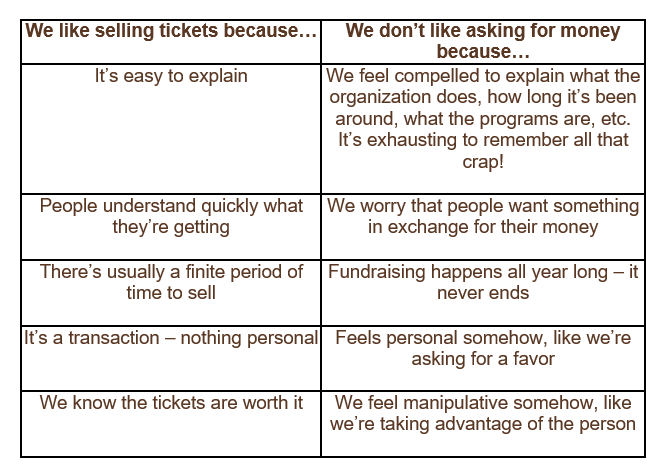When I use the word “fundraiser,” what comes to mind?
A dinner? Silent auction? T-shirt sales?
Most people are used to events and sales. Those are what I call fundraisers.
They are activities that are transactional in nature and designed to raise money from a purchase that someone makes from you.
But think about it – have you ever seen a fundraiser that raised a record-breaking amount of money? Can you fully fund your nonprofit’s budget from what you made off your last fundraiser?
Didn’t think so.
Oh, it’s possible. But most fundraisers bring in tiny little bits of money that leave you scratching your head wondering what you need to do next to raise money.
Why fundraisers?
I think most folks who are new to fundraising or inexperienced tend to gravitate to what they know.
They’ve seen fundraisers, been to them, even helped plan them.
They look like raffles, dinners, golf tournaments, 5Ks, bake sales, calendars, and T-shirt sales.
There’s nothing wrong with these – they have their place. They can be useful in generating a little money and sometimes awareness.
The problem is that there’s a limit to how much you can raise with one.
In every community on any given day, there’s a fundraiser happening. Sometimes more than one.
And when every nonprofit in town is doing them, they become so common that people stop paying attention to them, which means you have to work twice as hard just to get peoples’ attention.
So, is it possible to raise big money and do it without a fundraiser?
You bet.
Raise money without a fundraiser
Donor-based fundraising is different than a fundraiser.
Donor-based fundraising is about asking for money with the donor receiving nothing in return. (Or at least it appears that way.)
Many people don’t like this kind of fundraising. Even some who are employed to do it don’t like it. Yet it’s critical to sustainability.
You can’t create ongoing revenue doing one event after another.
You NEED a large group of donors around you who love the work your nonprofit does and are willing to help you successfully fulfill your mission.
You need people who give money that you can use however you need to, simply because they want to.
So if this is the kind of fundraising that is proven to be successful long-term, why is it so hard? Why is it easier to sell an event ticket than ask for a donation?
The Mindset of Good Fundraising
I believe it’s mindset.
We tend to steer clear of things that are uncomfortable or scary.
Asking for money leaves us vulnerable – what if they say ‘no?’ What if they don’t like us anymore because we asked them for something and made them feel uncomfortable?
For some people, it’s too much to risk. (By the way, this is why your Board members don’t want to ask for money or invite their friends to your event – it’s all mindset.)
Asking for donations feels too much like begging. And begging is basically settling for leftovers.
Yuck. Who wants leftovers? At best, you’ll get nickels and dimes.
And trust me – you will NEVER fully fund your budget with nickels and dimes.
In this 2.5 minute video, I’ll explain why some people are stuck in the fear of asking for money, and give you a tip that I personally use to overcome that fear.
So why DO some people like selling tickets instead of asking for money?
Here are some reasons:
So, what do you do? How do you shift your thinking to stop imagining fundraising as a negative thing?
Focus on the donor
Good fundraising is all about the donor.
In fact, if you simply stop thinking about the money and start thinking about the person, it’ll help you a lot. When you’re focused on the money, it’s all about you. When you’re focused on the donor, it’s all about them and your mission.
Here are some other tips:
- See donors as partners, not purchasers. This is an important shift. People are not ATMs. You can’t just get a check whenever you need it, with unlimited cash available. Your donors are your partners in making the good work happen – they have the money and you have the programs. Working together, your mission gets accomplished.
- Get your mindset handled. If you continue to shy away from everything that’s uncomfortable or scary, you’ll be running your whole life. Get some coaching to be brave enough to spend time with a donor and ASK for their support. Take it in baby steps if you have to – just start moving toward that goal of doing Fundraising instead of Fundraisers.
- Understand the ROI of Fundraisers vs Fundraising. Events will cost you 50 cents for every dollar you raise. That’s not a great return on your investment. Plus, if you factor in the staff time/cost, you may be in the hole on your event. Donor-based fundraising, or donor development, can cost as little as 10 cents to raise a dollar. That’s a WHOLE lot better return for your money. It just makes financial sense to spend time with donors.
- Picture donors as regular people. Donors aren’t necessarily “rich people” or “wealthy.” Yeah, they may have more money than you, but writing a check may be an easy way for them to help. Chances are good that they are in awe of you and wish they could do the boots-on-the-ground, front-line kind of work your nonprofit does. If they want to give, by all means, let them give!
- Envision a different future. Imagine how your stress level will go down when you aren’t constantly “hitting someone up” to buy a ticket for something. That alone should motivate you to move toward donor development.
- Keep the good words. Every time a donor tells you what an honor it is to support your organization, make a note of it. Keep the notes, emails, and cards they send telling you what great work your organization does. These words of encouragement will add up, then you can read through them anytime you need a little boost.
The RIGHT kind of Fundraiser
If you know about the 1-10-1000 Rule, you know that you should be doing 1 special event and doing it well.
Make it a signature event so that everyone in the community knows about it and associates it with your nonprofit. And make it a ton of fun so everyone looks forward to it, enjoys it, then talks about it for weeks afterward.
Do this 1 event, do it well, then spend the rest of your time on donor development, not more events.
You just WON’T raise big bucks doing event after event. Ditch the events that aren’t productive and aren’t fun for you or your guests.
Once you get that, it’s time to focus on your donors – those sweet people who love your cause and are willing to fund your good work.
If you’re doing LOTS of events and fundraisers now and you rely on that money, you may have to phase them out over time so you can replace that revenue with something else. Face it, $500 is $500, no matter where it comes from. Just make a plan of what you want to let go of and when, and start brainstorming about how you’ll replace it with revenue from individual donors who love your organization and want to support the good work you’re doing.
Then soon, you’ll be off the fundraiser hamster wheel and working on building up a big, loyal donor base.
And that’s where sustainability is.








Leave A Comment